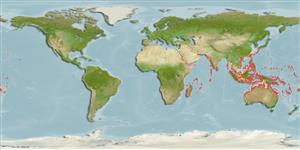Common names from other countries
Environment: milieu / climate zone / depth range / distribution range
นิเวศวิทยา
เกี่ยวกับทะเล,น้ำเค็ม เกี่ยวกับหินโสโครก; ระดับความลึก 0 - 80 m (Ref. 9773). Tropical; 32°N - 34°S, 27°E - 170°W
Indo-Pacific: East Africa and eastward through northern Australia to Samoa; north to southern Japan. Replaced by closely related Sufflamen albicaudatus in the Red Sea (Ref. 37816).
ขนาด / น้ำหนัก / Age
Maturity: Lm ? range ? - ? cm
Max length : 30.0 cm TL เพศผู้/กระเทย; (Ref. 30573)
เงี่ยงครีบหลัง (รวม) : 3; ก้านครีบอ่อนที่หาง (รวม) : 26 - 28; เงี่ยงครีบก้น: 0; ก้านครีบอ่อนที่ก้น: 23 - 26. Juveniles dark brown above, white below (Ref. 1602). Adult variable in color; the bar running through the pectoral base can either be yellow or black, and some individuals may be largely yellowish posteriorly (Ref. 1602).
Inhabit coastal to outer reefs. Habitats from silty lagoons to pristine outer reef walls (Ref. 48637). Occur in shallow lagoon and seaward reefs. Solitary and territorial. Feed on a wide variety of invertebrates. Also taken by drive-in nets (Ref. 9770). Oviparous (Ref. 205). Monogamous (Ref. 52884). Minimum depth reported taken from Ref. 128797.
Life cycle and mating behavior
Maturities | การสืบพันธุ์ | Spawnings | Egg(s) | Fecundities | ตัวอ่อน
Male defends a defined territory, within which a female resides. On the day prior to spawning, female pushes her snout into the sandy bottom repeatedly and removes small stones and pieces of coral at several sites. Adhesive eggs are deposited on the sandy bottoms or in a small cavity of the reef covered with sand. Female fans the eggs and defends the nest, while male patrols around female (Ref. 8603). Females are territorial, solely tending and guarding the eggs (Ref. 116451). Males exhibit polygyny (Ref. 116451).
Myers, R.F., 1991. Micronesian reef fishes. Second Ed. Coral Graphics, Barrigada, Guam. 298 p. (Ref. 1602)
IUCN Red List Status (Ref. 130435)
CITES (Ref. 128078)
Not Evaluated
Threat to humans
Harmless
Human uses
การประมง: มีการค้าเพียงเล็กน้อย; สถานที่แสดงสัตว์และพืชน้ำ: การค้า
เครื่องมือ
Special reports
Download XML
แหล่งที่มาจากอินเตอร์เน็ต
Estimates based on models
Preferred temperature (Ref.
115969): 24.8 - 29.3, mean 28.4 (based on 3050 cells).
Phylogenetic diversity index (Ref.
82804): PD
50 = 0.5312 [Uniqueness, from 0.5 = low to 2.0 = high].
Bayesian length-weight: a=0.02042 (0.01188 - 0.03509), b=2.94 (2.79 - 3.09), in cm Total Length, based on LWR estimates for this species & (Sub)family-body (Ref.
93245).
ระดับชั้นอาหาร (Ref.
69278): 3.8 ±0.20 se; based on food items.
ความสามารถในการกลับคืนสู่ปกติ (Ref.
120179): ขนาดกลาง, เวลาต่ำสุดที่จะทำให้ประชากรเพิ่มขึ้นเป็น 2 เท่าใช้เวลา 1.4 - 4.4 ปี (Preliminary K or Fecundity.).
Fishing Vulnerability (Ref.
59153): Low vulnerability (20 of 100).
